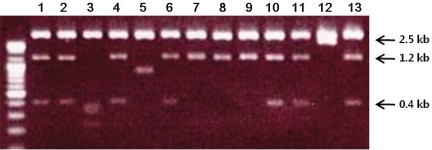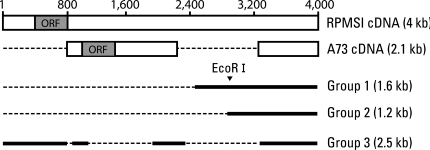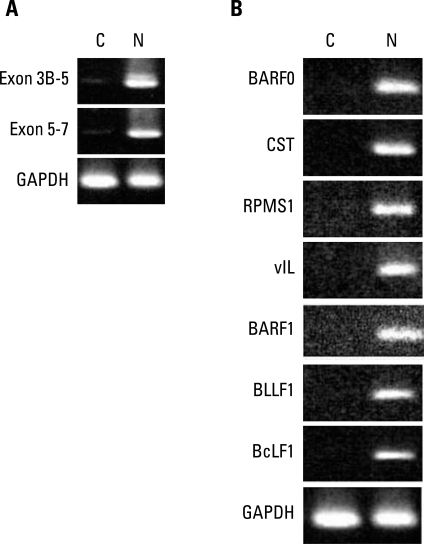Cancer Res Treat.
2011 Dec;43(4):250-254.
Expression of BamHI-A Rightward Transcripts in Epstein-Barr Virus-Associated Gastric Cancers
- Affiliations
-
- 1Department of Pathology, Seoul National University College of Medicine, Seoul, Korea. woohokim@snu.ac.kr
- 2Cancer Research Institute, Seoul National University College of Medicine, Seoul, Korea.
Abstract
- PURPOSE
About 10% of all gastric cancers (GCs) are Epstein-Barr virus (EBV)-associated. However, the oncogene of EBV in gastric carcinogenesis has not yet been established. In the present study, we investigated the virus-derived transcripts in the EBV-infected GC cell line to explore the viral oncogene of EBV-positive GCs.
MATERIALS AND METHODS
We used the SNU719 cell line, a naturally derived EBV-infected GC cell line. The individual expressed sequence tags from the cDNA libraries of SNU719 were searched against the mRNA subset extracted from the GenBank data base. Sequence reaction was carried out for the EBV-associated clones. Reverse transcription-polymerase chain reaction was performed after cells were partitioned into nuclear and cytoplasmic fractions.
RESULTS
Using bioinformatic tools, we selected 13 EBV-associated clones from cDNA libraries of SNU719. By sequencing analysis, we revealed that they were all associated with RPMS1, one of the BamHI-A rightward transcripts (BART) of EBV. Some BART cDNAs such as RPMS1 and A73 are known to be translated into protein in vitro, and have been shown to have some biochemical functions relevant to tumorigenesis. But, presently, the BART transcripts were expressed only in the nucleus and not in the cytoplasm, arguing against their role as messenger RNAs. Some other BART transcripts expressed in GCs (BARF0, CST, vIL, BARF1, BLLF1, and BcLF1) were also extensively detected in the nucleus.
CONCLUSION
BART transcripts are the predominant viral transcripts expressed in EBV-associated GCs, and they are located only in the nucleus. Therefore, it seems less likely that BART transcripts produce functional proteins to play a role in carcinogenesis of EBV-associated GCs.
Keyword
MeSH Terms
Figure
Reference
-
1. Thompson MP, Kurzrock R. Epstein-Barr virus and cancer. Clin Cancer Res. 2004; 10:803–821. PMID: 14871955.
Article2. Takano Y, Kato Y, Saegusa M, Mori S, Shiota M, Masuda M, et al. The role of the Epstein-Barr virus in the oncogenesis of EBV(+) gastric carcinomas. Virchows Arch. 1999; 434:17–22. PMID: 10071230.
Article3. Takada K. Epstein-Barr virus and gastric carcinoma. Mol Pathol. 2000; 53:255–261. PMID: 11091849.
Article4. Sugiura M, Imai S, Tokunaga M, Koizumi S, Uchizawa M, Okamoto K, et al. Transcriptional analysis of Epstein-Barr virus gene expression in EBV-positive gastric carcinoma: unique viral latency in the tumour cells. Br J Cancer. 1996; 74:625–631. PMID: 8761381.
Article5. zur Hausen A, Brink AA, Craanen ME, Middeldorp JM, Meijer CJ, van den Brule AJ. Unique transcription pattern of Epstein-Barr virus (EBV) in EBV-carrying gastric adenocarcinomas: expression of the transforming BARF1 gene. Cancer Res. 2000; 60:2745–2748. PMID: 10825150.6. Kim do N, Song YJ, Lee SK. The role of promoter methylation in Epstein-Barr virus (EBV) microRNA expression in EBV-infected B cell lines. Exp Mol Med. 2011; 43:401–410. PMID: 21628990.
Article7. Lee JE, Hong EJ, Nam HY, Kim JW, Han BG, Jeon JP. MicroRNA signatures associated with immortalization of EBV-transformed lymphoblastoid cell lines and their clinical traits. Cell Prolif. 2011; 44:59–66. PMID: 21199010.
Article8. Song LB, Zen MS, Zhang L, Li MZ, Liao WT, Zheng ML, et al. Effect of EBV encoded BARF1 gene on malignant transformation of human epithelial cell line HBE. Ai Zheng. 2004; 23(11 Suppl):1361–1364. PMID: 15566637.9. Wiech T, Nikolopoulos E, Lassman S, Heidt T, Schöpflin A, Sarbia M, et al. Cyclin D1 expression is induced by viral BARF1 and is overexpressed in EBV-associated gastric cancer. Virchows Arch. 2008; 452:621–627. PMID: 18437417.
Article10. Oh ST, Seo JS, Moon UY, Kang KH, Shin DJ, Yoon SK, et al. A naturally derived gastric cancer cell line shows latency I Epstein-Barr virus infection closely resembling EBV-associated gastric cancer. Virology. 2004; 320:330–336. PMID: 15016554.
Article11. Al-Mozaini M, Bodelon G, Karstegl CE, Jin B, Al-Ahdal M, Farrell PJ. Epstein-Barr virus BART gene expression. J Gen Virol. 2009; 90(Pt 2):307–316. PMID: 19141439.
Article12. Jung EJ, Lee YM, Lee BL, Chang MS, Kim WH. Ganciclovir augments the lytic induction and apoptosis induced by chemotherapeutic agents in an Epstein-Barr virus-infected gastric carcinoma cell line. Anticancer Drugs. 2007; 18:79–85. PMID: 17159505.13. Hitt MM, Allday MJ, Hara T, Karran L, Jones MD, Busson P, et al. EBV gene expression in an NPC-related tumour. EMBO J. 1989; 8:2639–2651. PMID: 2479554.
Article14. Smith PR, de Jesus O, Turner D, Hollyoake M, Karstegl CE, Griffin BE, et al. Structure and coding content of CST (BART) family RNAs of Epstein-Barr virus. J Virol. 2000; 74:3082–3092. PMID: 10708423.
Article15. Zhang J, Chen H, Weinmaster G, Hayward SD. Epstein-Barr virus BamHi-a rightward transcript-encoded RPMS protein interacts with the CBF1-associated corepressor CIR to negatively regulate the activity of EBNA2 and NotchIC. J Virol. 2001; 75:2946–2956. PMID: 11222720.16. Li A, Zhang XS, Jiang JH, Wang HH, Liu XQ, Pan ZG, et al. Transcriptional expression of RPMS1 in nasopharyngeal carcinoma and its oncogenic potential. Cell Cycle. 2005; 4:304–309. PMID: 15725729.
Article17. Pfeffer S, Zavolan M, Grässer FA, Chien M, Russo JJ, Ju J, et al. Identification of virus-encoded microRNAs. Science. 2004; 304:734–736. PMID: 15118162.
Article18. Edwards RH, Marquitz AR, Raab-Traub N. Epstein-Barr virus BART microRNAs are produced from a large intron prior to splicing. J Virol. 2008; 82:9094–9106. PMID: 18614630.
Article19. Kim do N, Chae HS, Oh ST, Kang JH, Park CH, Park WS, et al. Expression of viral microRNAs in Epstein-Barr virus-associated gastric carcinoma. J Virol. 2007; 81:1033–1036. PMID: 17079300.
Article20. Barth S, Pfuhl T, Mamiani A, Ehses C, Roemer K, Kremmer E, et al. Epstein-Barr virus-encoded microRNA miR-BART2 down-regulates the viral DNA polymerase BALF5. Nucleic Acids Res. 2008; 36:666–675. PMID: 18073197.
Article
- Full Text Links
- Actions
-
Cited
- CITED
-
- Close
- Share
- Similar articles
-
- Epstein-Barr Virus-associated Gastric Carcinoma
- A Case of Epstein-Barr Virus-Positive Diffuse Large B-Cell Lymphoma Occurring in Thyroid Gland
- Clinical Significance of Epstein-Barr Virus Expression in Breast Cancer
- Expression of p53 Protein and Proliferating Cell Nuclear Antigen in Epstein - Barr Virus-associated Gastric Adenocarcinoma
- Predictive Factors of Epstein-Barr Virus Association in Gastric Adenocarcinoma




